I am trying to write my own Game of Life, with my own set of rules. First 'concept', which I would like to apply, is socialization (which basicaly means if the cell wants to be alone or in a group with other cells). Data structure is 2-dimensional array (for now).
In order to be able to move a cell to/away from a group of another cells, I need to determine where to move it. The idea is, that I evaluate all the cells in the area (neighbours) and get a vector, which tells me where to move the cell. Size of the vector is 0 or 1 (don't move or move) and the angle is array of directions (up, down, right, left).
This is a image with representation of forces to a cell, like I imagined it (but reach could be more than 5):
Let's for example take this picture:
Forces from lower left neighbour: down (0), up (2), right (2), left (0)
Forces from right neighbour : down (0), up (0), right (0), left (2)
sum : down (0), up (2), right (0), left (0)
So the cell should go up.
I could write an algorithm with a lot of if statements and check all cells in the neighbourhood. Of course this algorithm would be easiest if the 'reach' parameter is set to 1 (first column on picture 1). But what if I change reach parameter to 10 for example? I would need to write an algorithm for each 'reach' parameter in advance... How can I avoid this (notice, that the force is growing potentialy (1, 2, 4, 8, 16, 32,...))? Can I use specific design pattern for this problem?
Also: the most important thing is not speed, but to be able to extend initial logic.
Things to take into consideration:
- reach should be passed as a parameter
- i would like to change function, which calculates force (potential, fibonacci)
- a cell can go to a new place only if this new place is not populated
- watch for corners (you can't evaluate right and top neighbours in top-right corner for example)

